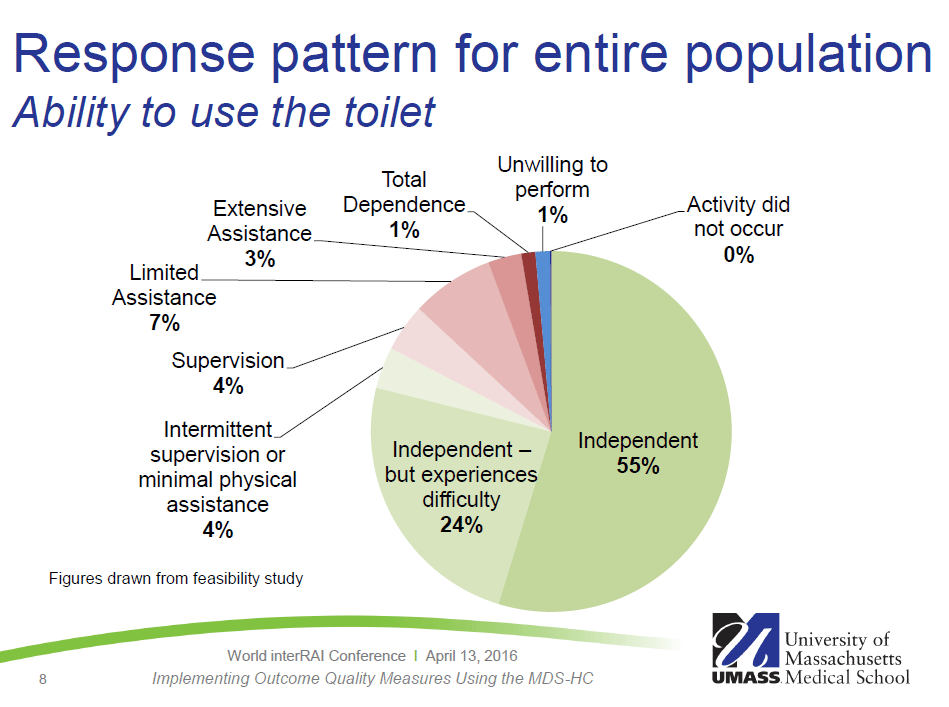26 January 2020
ADLs are the daily self-care activities we do every day without thinking — getting out of bed, showering, getting dressed, going to the bathroom, feeding ourselves (#Selbstpflege in German). For someone with decreased mental or physical capacity, the ability to perform ADLs determines the level of care they need. #ADLs are measured both for home and institutional care settings (#nursing facilities, #rehabilitation).
As the chart shows, a person can perform an ADL completely or mostly independently; need supervision or help of varying levels; or be completely dependent on assistance. (Graph is from my co-presentation at the 2016 interRAI conference while working at the University of Masschusetts Medical School’s Health Law & Policy Center.)
There are multiple tools available to assess clients’ ADLs, including interRAI (shown in the graph) and the EPa-CC (ergebnisorientiertes PatientenAssessment), and the Enhanced Barthol Index (#EBI), as well as home-grown systems developed by governing agencies, hospitals, or other providers. Each software system typically has a specific survey for different care settings, such as home care, emergency room, and long-term care (Pflegeheim/nursing facility), and for specialized populations such as children. But all will have the same types of core questions about a person’s ability to perform ADLs. (For an interesting study comparing EBI and EPa, click here.)
For home care settings, additional information is critical: can the person manage the intellectual activities of living independently, including cooking, shopping for groceries, getting to and from community locations, cleaning the house and paying bills. These are called Instrumental Activities of Daily Living, or #iADLs. They answer the question of whether it is safe for the person to be living at home.
Someone might need help with ADLs, iADLs, or both, and a disability in one area does not necesarily hinder the person’s ability to live at home. The type and duration of support they receive should be tailored to the identified needs. For example, a client who needs help showering might need a home care worker twice a week for a couple of hours, while someone else might require assistance every morning to get out of bed, get dressed, and prepare for the day. A client might need a second level of support to do household chores, but those needs can sometimes be met through informal care or volunteers, such as a son or daughter who takes charge of their parents’ bills, a cleaning service, or a neighbor who takes the person shopping once a week. I’ve also heard of volunteer programs that send (verified) volunteers to the homes of elders once a month to help them sort through, understand, and pay their bills. Someone with severe ADL limitations might still have the intellectual capacity to manage their own household, while another, able-bodied person with dementia has a different set of needs.
As you will hear repeatedly in these blogs, I’m a big believer in collecting and using data. Next week, I’m going to the 2020 interRAI Conference, where I will learn more about specific ways interRAI’s data is used and adapted to better serve clients.
What ADL index system do you use? What strengths and weaknesses do you feel it has? How does your organization, or the organization serving your loved on, use the data? Is your loved one able to get all the care they need? Feel free to share your thoughts on this topic in the Comments section.
#longtermcare #LTC #LTSS


I am familiar with the InterRAI tool and some agency developed tools used to measure the ability to perform ADLs and IADLs. I’m interested in hearing about any of these tools being used to predict when an individual might need an intervention (for example, to prevent the risk of falls), and how agencies might be using the data from these tools to help support individuals in the community.
Use of assessment data for quality measurement, service planning, and service authorization is possible with validated assessment tools like the MDS-HC. Looking forward to hearing more from next week’s interRAI conference!